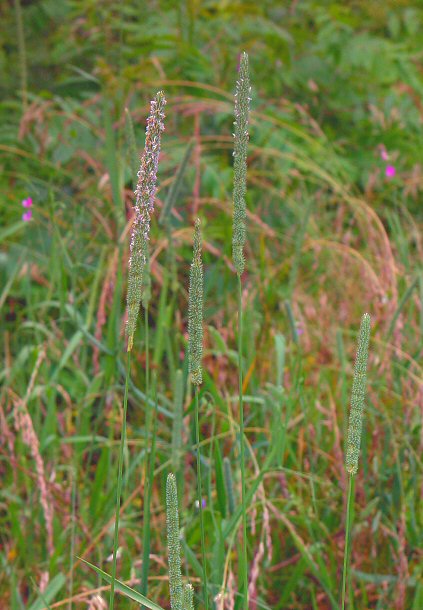Phleum pratense L.
Timothy

Introduced
CC = *
CW = 3
MOC = 71
© DETenaglia
Phleum pratense L.Timothy | |
 |
Introduced CC = * CW = 3 MOC = 71 |
© DETenaglia |
|
Family - Poaceae/Aveneae Habit - Perennial grass, sometimes relatively short-lived, forming tufts, with C3 photosynthesis (cool season). Stems - Flowering stems erect, to 1 m, sometimes from spreading bases, usually swollen and somewhat bulblike at the base, glabrous or roughened toward the tip.
Leaves - Leaf sheaths open most of their length, rounded on the back, glabrous, the membranous ligule 1-5 mm long. Leaf blades 3-30 cm long, 3-8 mm wide, flat, glabrous or roughened along the margins.
Inflorescences - Appearing as dense, cylindrical spikes, 3-15 cm long, the short branches fused to the main axis.
Spikelets - Spikelets 1.8-3.2 mm long (excluding the awns), strongly flattened laterally, disarticulating above the glumes, the glumes also sometimes shed with age, with 1 perfect floret and without additional staminate or sterile florets.
Flowers - Glumes with the body 1.8-3.2 mm long, longer than the lemma, similar in size and shape, oblong, abruptly rounded or narrowed at the tip to an awn 0.5-1.5 mm long, strongly keeled and 3-nerved, thin and membranous along the margins, hairy on the nerves. Lemma 1.3-2.4 mm long, thin and membranous, oblong-elliptic, rounded to abruptly pointed at the tip, awnless, 5-nerved, glabrous. Palea similar in appearance to the lemma but slightly shorter. Stamens 3, the anthers 1.2-1.8 mm long.
Fruits - Caryopses 1.0-1.4 mm long, oblong-elliptic in outline, yellowish brown. Flowering - May - August. Habitat - Upland prairies, pond margins, streambanks, pastures, cultivated fields, ditches, roadsides, railroads, open disturbed areas. Origin - Native to Europe. Lookalikes - Alopecurus pratensis. Other info. - This common species can be found throughout Missouri, as well as across most of the continental U.S. except for the Gulf Coast states. It is straightforward to identify in the field from its dense cylindrical inflorescences. However, it can mimic some other species, Alopecurus in particular. A close look with a hand lens will show the distinctively awned glumes of the florets. Photographs taken at the Holly Ridge Conservation Area, Stoddard County, MO., 6-14-03, and near the Owl's Bend Campground, Shannon County, MO., 6-13-05 (DETenaglia); also at Shaw Nature Reserve, Franklin County, MO, 6-23-2021 (SRTurner). |